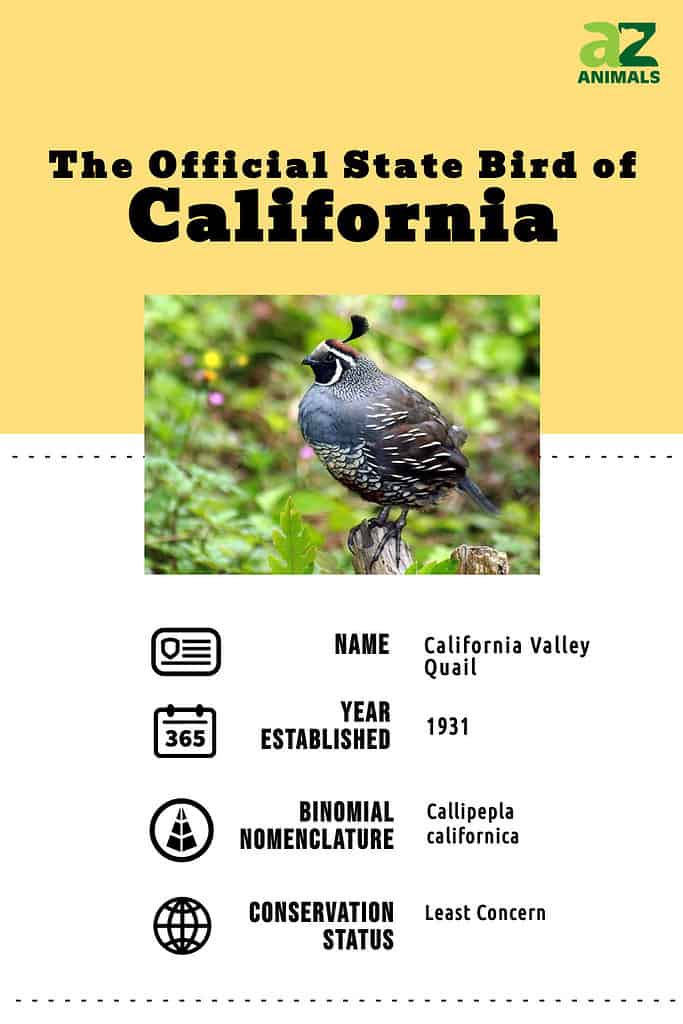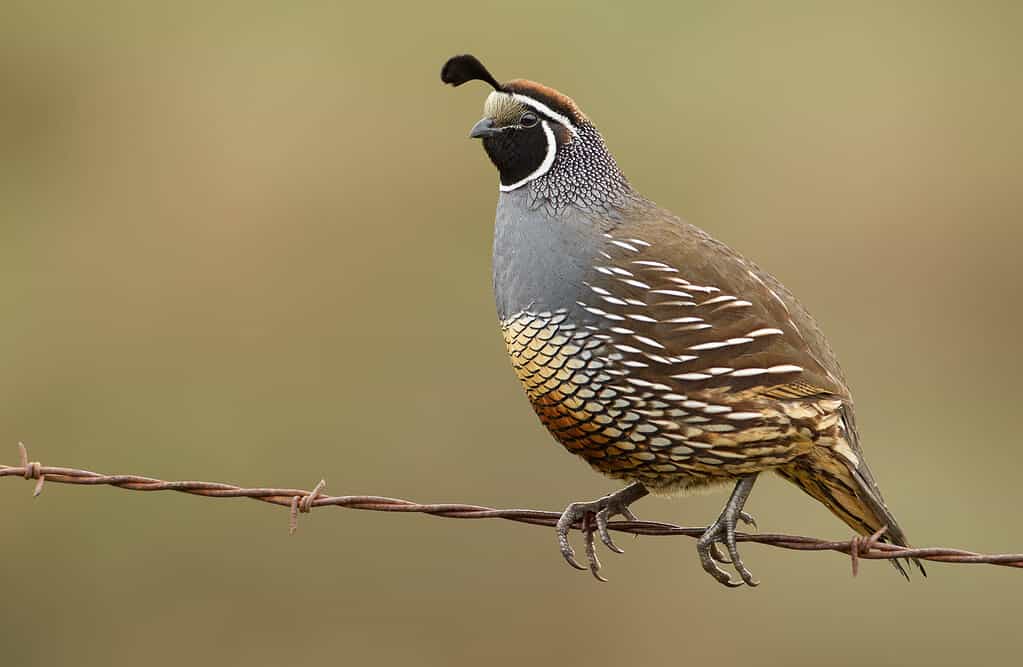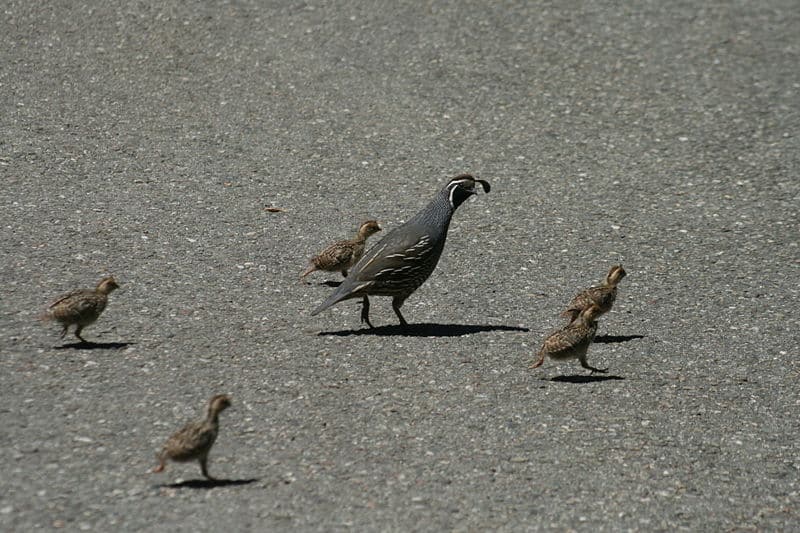The official state bird of California is the California Valley quail (Callipepla californica; formerly Lophortyx californica). This small, ground-dwelling bird, easily recognized by the distinct plume of feathers on its forehead, was proclaimed the official state bird of California in 1931!

While the bird is widely distributed throughout California, California Valley quail prefers specific habitats. Find this bird in grasslands, chaparral, and oak woodlands that are more prevalent in the Western part of the state. Its unique appearance and interesting behavior make it a beloved symbol of California’s wildlife. Keep reading to learn more about this captivating bird!
What’s in a Name / Disambiguation
In 1957 the American Ornithological Society reclassified Lophortyx californica moving it into the genus Callipepla. At that time, the new scientific name for the California quail became Callipepla californica.
This taxonomic change was proposed many years earlier by the American field biologist Joseph Grinnell, in The Distribution of the Birds of California. Grinnell’s proposal was based on a study of the morphology and behavior of the quail species. This led him to conclude that the California Valley quail belonged to the genus Callipepla. Since the taxonomic change, the California Valley quail has been widely referred to by its new scientific name, Callipepla californica. It is recognized as a member of the Callipepla genus by most authorities.
The Official California State Bird: Where Can You See it?
The California Valley quail can be found in various parts of California, particularly in the western region of the state. Here are some of the best places to see California Quail:
- Central Valley: The California Valley quail is commonly found in the Central Valley region of California, particularly in areas with grasslands and oak woodlands.
- Point Reyes National Seashore: This park located in Marin County is known for its diverse wildlife, including the California quail. Visitors can see the birds foraging on the ground in grassy areas.
- Griffith Park, Los Angeles: This park in the heart of Los Angeles is home to a population of California quails. Visitors can often see them foraging for food on the ground.
- Utah: Callipepla californica was introduced to the state in 1869. California quail are now a common sight in Salt Lake City parks, golf courses, and backyards!
Appearance
The California Valley quail is a small, plump bird that is approximately 9-10 inches (22-25 cm) in length, weighing between 5-6 ounces (141-170 grams). It has a wingspan of 14 inches (35.5 cm)! It has a distinct forward-curling plume on its head, a short, curved beak, and a round body.

The male has a black face with a white outline and a white stripe above its eyes.
©Agnieszka Bacal/Shutterstock.com
The male has a black face with a white outline and a white stripe above its eyes. Its body is mostly brown with black and white markings. It has a rust-colored breast with white patches that appear as a fish scale pattern. Its beak is short, pointed, and black. The female has a similar body pattern but is more muted. Females also lack the distinctive face and head markings of males.
Both males and females have a distinctive call, which is a series of short, rhythmic notes that sounds like Chi-ca-go! or pah-WEY! They are often seen in small flocks and can be found in grasslands, foothills, and agricultural areas.
The Official California State Bird: Behavior
California Valley quails are social birds and are often found in groups known as coveys. They are active during the day and spend much of their time on the ground, foraging for food and taking dust baths to keep their feathers clean. When disturbed, they will often gather in a tight circle with their heads facing outward, ready to fly away if necessary. This behavior is known as quail huddle and is a defense mechanism against predators and a way to stay warm in the winter.
California Valley quails are serially monogamous, mating for only one season. During the breeding season, males will perform courtship displays, such as puffing up their feathers and calling out to females. The female will then lay a clutch of 12-28 eggs in a shallow depression on the ground, which she will incubate for about three weeks until they hatch. Males take an active role in the rearing of the chicks.
The Official California State Bird: Habitat

California quail are native to the western US, and in California, they live in the western half of the state.
©iStock.com/Banu R
The California Valley quail is native to the Western United States. In California, they are primarily found in the Western half of the state, from the Central Valley to the coast and into the foothills of the Sierra Nevada mountain range. California Valley quail prefer habitats with a mixture of open grasslands and brushy areas, such as chaparral, sagebrush, and oak woodlands. They are also found in agricultural areas, especially where crops like alfalfa and grains are grown. They are non-migratory birds and tend to stay in their home range throughout the year. During the winter, they may move to lower elevations to escape the snow and avoid cold temperatures.
The Official California State Bird: Diet
California Valley quail primarily feed on seeds of grasses, wildflowers, and clover. They also eat insects, such as beetles, ants, and grasshoppers, as well as fruits and berries when they are available.
In agricultural areas, they may eat crops such as alfalfa, grains, and corn, but they generally do not cause significant damage to crops. In fact, California Valley quail can be beneficial to farmers as they feed on insects that could potentially damage crops.
California Valley quail have a strong digestive system that allows them to extract nutrients from seeds. They have a muscular gizzard that grinds up the seeds they eat and a cecum that ferments the seeds to break them down further. This allows them to extract more nutrients from the seeds and helps them to survive in arid regions with limited food resources.
The Official California State Bird: Predators

California Valley quail depend on their ability to hide and blend in with their surroundings.
The official state bird of California faces threats from a variety of predators. Birds of prey like hawks and falcons are a significant threat to California Valley quail, swooping down and capturing them in flight or on the ground. Coyotes and foxes will prey on these birds and their eggs, principally during the nesting season. Gopher snakes and rattlers will slither into a quail’s nest in search of a nice meal of quail eggs. Feral and domesticated cats are also predators of these birds.
California Valley quail depend on their ability to hide and blend in with their surroundings, as well as their ability to fly short distances to escape danger. They also use group behavior to protect themselves. Coveys of 10-200 quails will travel and feed together, and they are known to emit warning calls and signals when a predator is nearby.
The Official California State Bird: In New Zealand
The California Valley quail was introduced to New Zealand for hunting and farming purposes in the late 1800s. The bird was well-suited to the local environment and quickly established breeding populations in various regions of the country. Today, the California Valley quail is considered a game bird in New Zealand and is hunted recreationally. However, its introduction has also had some negative effects on native bird species, as the California Valley quail competes with them for food and habitat, and is known to hybridize with some species of native quail.
Five Facts About Callipepla californica
- The California Valley quail’s head plume is actually a cluster of six overlapping feathers.
- California Valley quails are known for their elaborate courtship displays, which involve the males puffing up their chest feathers, calling loudly, and strutting around in circles to attract a mate.
- California Valley quails have a relatively short lifespan of only 3-5 years in the wild, due to high predation rates and environmental factors. The oldest known California quail lived almost seven years – 6 years and 11 months.
- California Valley quail are recreational game birds in California and are prized for their tender, flavorful meat. However, hunting regulations and conservation efforts have helped to ensure that their populations remain stable and sustainable.
- Approximately 40 minutes before the sun rises, California Valley quail will have a covey call, in which members of the covey check in using their distinctive Chi-ca-go! call.
The photo featured at the top of this post is © Agnieszka Bacal/Shutterstock.com
Thank you for reading! Have some feedback for us? Contact the AZ Animals editorial team.






